This week, the National Oceanic and Atmospheric Administration withdrew its proposal to expand the size and focus of the Hawaiian Islands Humpback National marine Sanctuary. The six year planning developed designs to enlarge the sanctuary from 1,366 square miles to 1,601 square miles in order to expand the number of protected species. The national sanctuary was established in 1992 and is one of the world’s most important humpback whale habitats. Opposition to this proposal came from residents concerned that the expanded sanctuary would restrict recreational ocean use and hurt business . Read more…
 This National Geographic article discusses the expedition to deploy a Crittercam on the gentle giants of the ocean, the whale shark. These cameras provide 6 hours of footage on the view of the activity of the whale shark which still remains a bit of a mystery. To watch some of the video and learn more about how the Crittercams are attached to the whale sharks, click here…
This National Geographic article discusses the expedition to deploy a Crittercam on the gentle giants of the ocean, the whale shark. These cameras provide 6 hours of footage on the view of the activity of the whale shark which still remains a bit of a mystery. To watch some of the video and learn more about how the Crittercams are attached to the whale sharks, click here…
Have you ever been in a Florida hotel on the beach and heard the request to draw your blinds during the evening? If so, this is a method to support turtle nesting season. New research, that actually started as a high school science project, confirmed that the density of sea turtle nests on Florida beaches is reduces where artificial lights along the coast deter nesting females. The scientists use satellite-derived data to determine what areas need more effective management of artificial light. it appears that the light mitigation policies are working in Florida and loggerhead, green, and leatherback turtle nests have increased. Read more…
5. Intact Nature Offers Best Defense Against Climate Change
 A paper published in Natural Climate Change, discusses how certain adaptive strategies may have a negative impact on nature which in turn will impact people in the long term. According to CSIRO’s principle research scientist Dr. Tara Martin, ” in response to climate change, many local communities around the world are rapidly adjusting their livelihood practices to cope with climate change, sometimes with catastrophic implication for nature”. The paper states that intact native forests have been shown to reduce the frequency and severity of floods, while coral reefs can reduce wave energy by an average of 97% to provide defense against storm surges. Read more…
A paper published in Natural Climate Change, discusses how certain adaptive strategies may have a negative impact on nature which in turn will impact people in the long term. According to CSIRO’s principle research scientist Dr. Tara Martin, ” in response to climate change, many local communities around the world are rapidly adjusting their livelihood practices to cope with climate change, sometimes with catastrophic implication for nature”. The paper states that intact native forests have been shown to reduce the frequency and severity of floods, while coral reefs can reduce wave energy by an average of 97% to provide defense against storm surges. Read more…

Last weekend, three sperm whales were found washed up on the Lincolnshire coast of England. Scientists took autopsy samples to determine root cause for the death of the whales. The whales were then transported by large construction equipment and buried in a local landfill. Potential cause for these deaths have not been released. Read more…
Be sure to “LIKE” http://facebook.com/SeaSave to ensure our “Week in Review” is delivered to your newsfeed every Thursday.






